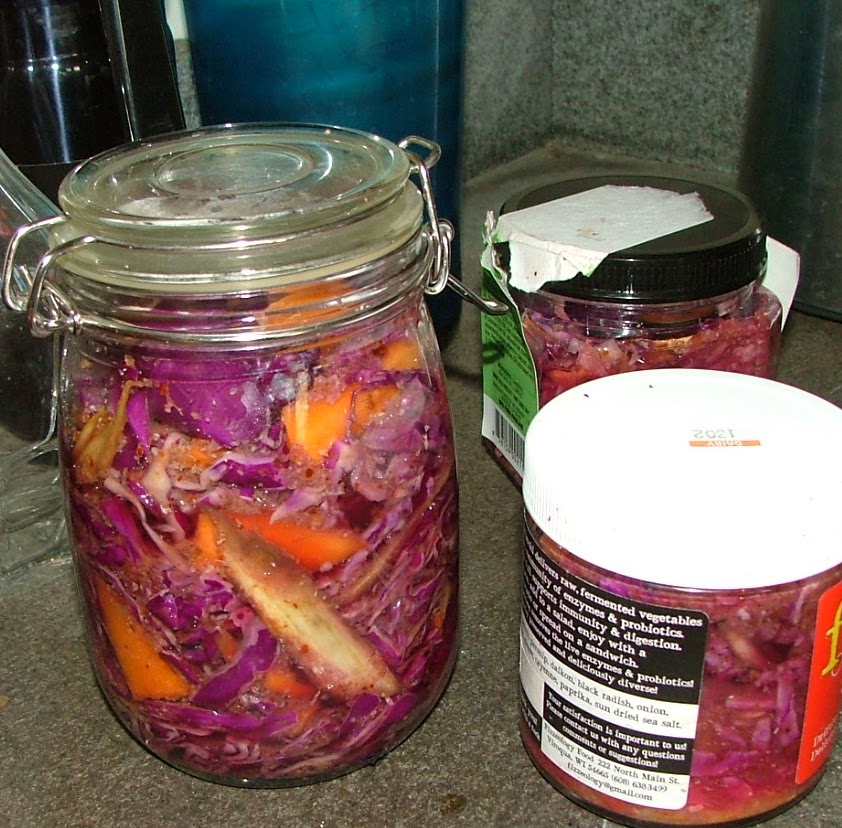Welcome to my blog:) I hope that today brings you happiness and good health!
Saturday, March 28, 2015
Saltless Fermented Vegetables
This month, I have had to deal with some gut issues and under my gastro intestinal doctors request, I have begun to pay much more attention to my digestive system. mong other things, I have committed to eating fermented foods every day.
The month has been extremely hectic though so I began with store bought (the jars on the right in the photo) but each jar cost around 10 dollars. Both are high quality and locally produced so in a pinch, I don't mind splurging.
However, there is nothing easier than fermenting your own foods and drinks! I bought the Body Ecology Veggie Culture Starter awhile back when my husband was put on a salt restricted diet. I was pretty sure that there was no reason to use salt at all for fermenting but everybody and their uncle were telling me I was out of luck-that salt was crucial. I remembered reading a saltless recipe for fermented greens in the Wild Fermentation book though so I knew that there was more to fermenting than than adding salt.
A little research and I uncovered the starter and couldn't be happier.
In this Kim Chi flavored batch, I only have purple cabbage, carrots and burdock root and some flavoring.
First order of business is to shred the cabbage (I used 1.5 small heads), slice the carrot (about a pound) and burdock (one thick 12 inch root).
To a blender, I added 3 very large cloves of garlic, about 3 inches of ginger and a handful of the cabbage, carrot and burdock. I added about a cup of water and blended until smooth. I then added the Korean red pepper flakes and one packet of the starter culture and blended once more.
I also had some fluids left in each storebought jar so I added that to the blend too. I have never done this so we shall see what happens. Probably nothing except a slightly salted flavor.
I then poured this brine over the vegetables and covered it for an hour. This isn't mandatory but I like to let my ferments sit before putting into jars.
When transfering to the clean (sterile) jars, I used a handful of the vegetables at a time and a pestle to crush the vegetables down.
In this method, the jars are sealed immediately and left to sit for 2-7 days. The instructions say the longer the better. I like my ferments on the crispy side which is why I make small batches.
I highly recommend ferments in particular and will be doing more of them soon. Some of the reasons for eating/drinking them are commonly known but there are other reasons that recent research is uncovering that I would like to delve into more-such as how these frienly bacteria colonies actually affect mood and the function of the brain.
Stay tuned!
Labels:
Body Ecology,
ferments
Subscribe to:
Post Comments (Atom)

I made a fermented cabbage, and added way too much salt!!! I had to remove it from the jar and rinse it thoroughly before I could actually eat it. The recipe I used called for fennel seeds, which gave the cabbage a lovely earthy flavour. I haven't done it again, because it did seem like a lot of trouble to go to, for a dud batch. Nursing my pride, lol, that's the only excuse I can give for not trying again.
ReplyDeleteDoing small batches though, seems like a way to go. Now why didn't I think of that? So simple! Thanks for sharing.
It took me several tries to get the process down. I would make and throw them out to the chickens because I was afraid of the results. lol. My friend Mary took a jar the last time I made a large batch last summer and she is still alive-I saw her taste it before my eyes so I now KNOW I am not creating food poisoning. lol. But there is a way to figure out how much salt to use (if using it) and its by weight. I can't remember but the Amish told me how they do it. Sauerkraut is a happy family activity to them. I will ask again as they have shared their kraut with me and it is very very delicious.
DeleteDon't give up!
I tried it again, and love it! I used half a head of cabbage, 3 teaspoons of salt and to add more liquid, dropped in a bit of my homemade pineapple vinegar, so it tastes a little like pickled cabbage. I'm making another batch tomorrow. I now want to grow cabbages and have ordered seeds, lol.
ReplyDeleteIf you do get a chance to ask about the weight to salt ratio, I'd be interested to know. Thanks. :)
I will definitely ask soon and let you know. I am so proud of you! Its not that hard to do after all! The Amish use large batches and hope it will last all winter and into spring so I think they have the best ratios but I believe its the same as other sources-3 tablespoons to 5 lbs of cabbage but the cabbage is weight after it is chopped up. To break that down to small batches would require somebody other than me! lol. I will ask them to confirm this though. I like the idea of vinegar! I add ginger and garlic myself:) Oh and the Amish prefer their fall cabbage for this as its got more water in it.
Delete